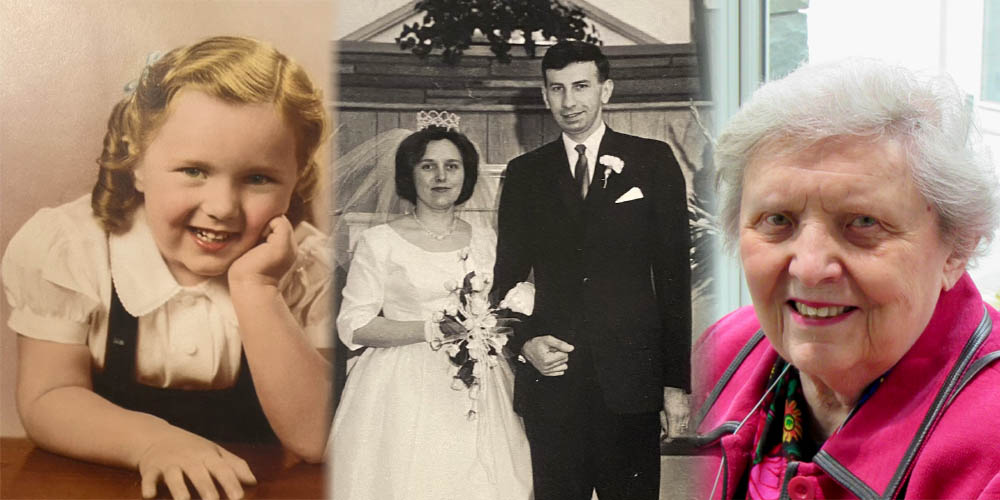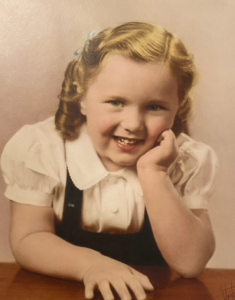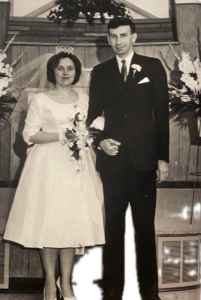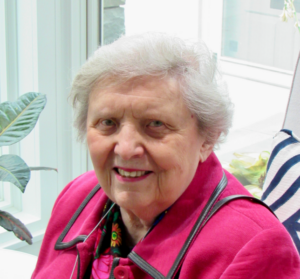
How a Scholarship Opened the Door for an Accomplished Career
by Esther Friedmann, courtesy of Faculty Women’s Club of the University of Michigan
FWC Golden Member Corner: Margaret Lomax
Margaret retired from the University of Michigan Medical School in 2008 after a long career as an accomplished research professor specializing in molecular biology and recombinant DNA technology.
Margaret was born in Virginia and spent the first 5 years of her life in southeastern Kentucky. In 1942, her mother left her with her aunt and uncle so that she could help with the war effort. Her mother was a Rosie the Riveter, working in the machine shop at Republic Steel in Cleveland, where she met and married Margaret’s stepfather. Margaret grew up in Cleveland and its suburb, Maple Heights.

Not Shirley Temple!
Margaret at age 4
When I was in High School in the early 1950’s, there weren’t many career options for women. Most girls aspired to be a teacher, a nurse, a secretary, or a wife. Since I was good at and liked science, I planned to be a nurse.
There were two kinds of nursing schools back then: a 3-year program associated with a hospital, or a 5-year program consisting of 2 years of college, followed by 3 years of nursing training. I planned to attend the 5-year program at Francis Payne Bolton School of Nursing, at Western Reserve University (WRU), although in retrospect I am not sure how I planned to pay for the 2 years of college. WRU did give me a full scholarship for the first year of college, so perhaps that was how.
Meanwhile, a very fortuitous event occurred. My dad was a member of the United Steelworkers Union. That year (1956) the Steelworkers Union decided to create a 4-year college scholarship for either union members or their children. My dad wasn’t aware of this scholarship opportunity, but fortunately I learned of it from one of my classmates, whose father was also a union member. My dad signed me up to take the test just in the nick of time.
The applicants went to WRU to take a test (probably the equivalent of the SAT, which wasn’t used a lot back then). I have a picture somewhere of the applicants taking the test, which appeared in the Cleveland newspaper. Of the 90-some applicants, I received the highest score and therefore won the 4-year scholarship, worth about $2200 or $2600, I can’t remember which. (College tuition was much lower back then). The scholarship meant that I could major in science (Chemistry), obtain a good liberal arts education, and get into a good Biochemistry graduate program at Michigan, where I obtained my Ph.D. in Biochemistry. And, as they say, “the rest is history”.
After completing her B.A. degree in Chemistry at Case Western Reserve University, Margaret came to the University of Michigan in 1960 and completed her Ph.D. in Biochemistry in 1964. She stayed on at the same lab as a post doctorate for a couple of years, working on different projects. In 1962, she met Ron
Lomax, a visiting Assistant Professor of Electrical Engineering at U-M, at a performance of Beethoven’s Ninth Symphony at Hill Auditorium. They married in 1964.

Margaret and Ron
in 1964
Margaret took four years off to raise their two children, Cathy and Ian. She resumed her research at a very fortuitous time, getting involved in a groundbreaking new technology: recombinant DNA. She became one of the first molecular biologists at the University to use these techniques. This technology, which was developed in the early 1970s by groups at Stanford and Berkeley, led to DNA cloning. Later in her career, she was co-director of the Michigan Diabetes Research and Training Center, Molecular Biology Core Facility, then director of the DNA Sequencing Core.
After moving to the Medical School, her research involved the molecular genetics of noise induced and age-related hearing loss. She has been the principal/co-principal investigator on 30 grants, published 77 articles, and served on numerous committees and grant review boards. Margaret has been a role model to many undergraduate, graduate, and medical students. In 2002 Margaret was honored with the University of Michigan Research Scientist Achievement Award which recognizes “outstanding scholarly achievements, including the discovery and dissemination of new knowledge, the development of innovative technology, or the development of concepts that lead to advances in science, education, health, the arts of humanities.”

Margaret retired from the Kresge Hearing Research Institute in 2008 but continued working part time until 2014.
When Margaret became a Faculty Wife in 1964, she was invited to join a FWC book discussion group where she met Daryl Hafter, another FWC golden member. Margaret and Daryl have remained friends for all these years. While working and pursuing her career, Margaret only had time to participate in the book discussion group. After retiring, she joined additional book clubs and became more active. She served as book group coordinator, assistant treasurer for 2 years and treasurer for one year. She also participated in various committees including the endowment and nominating committees. She continues to participate in FWC trips. After 60 years as an FWC member, Margaret thinks that creating lifelong friendships may be the most important aspect of the FWC.
Looking for a scholarship opportunity to help launch your career? Apply now for
the Union Sportsmen’s Alliance Scholarship Program by March 31, 2025.




